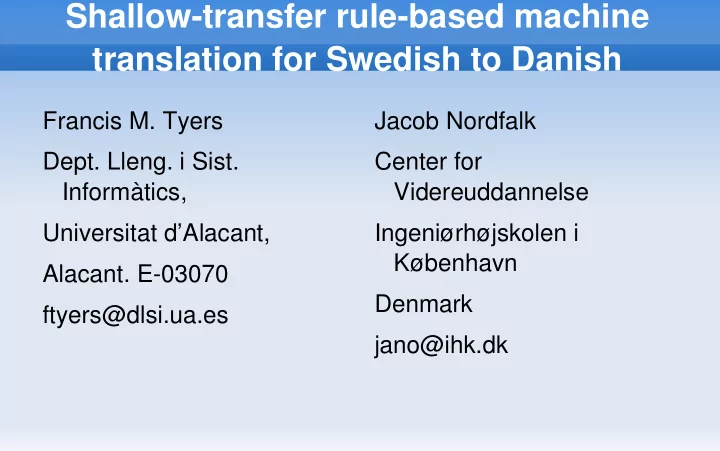

Shallow-transfer rule-based machine translation for Swedish to Danish Francis M. Tyers Jacob Nordfalk Dept. Lleng. i Sist. Center for Informàtics, Videreuddannelse Universitat d’Alacant, Ingeniørhøjskolen i København Alacant. E-03070 Denmark ftyers@dlsi.ua.es jano@ihk.dk
Agenda Apertium Swedish-Danish Language differences / structural transfer Dictionary structure / lexical transfer challenges Challenges in a Google Summer of Code (GSOC) project Tools used to collect data Evaluation
The Apertium project Apertium is an open-source (GPL) machine translation platform. The platform provides a language-independent MT engine tools to manage linguistic data for language pairs linguistic data for a lot of language pairs ⇆ ⇆ ⇆ ⇆ ⇆ Esperanto English Swedish Danish Catalan Romanian Welsh English English ⇆ ⇆ ⇆ ← Afrikaans English Catalan English Spanish English Polish Esperanto Catalan ← ← ⇆ ⇆ ⇆ Esperanto Spanish Esperanto Nepali Spanish Catalan Spanish Galician Spanish ⇆ ← ⇆ ⇆ Italian Spanish Portuguese Spanish Romanian Basque Spanish French Catalan ⇆ ⇆ ⇆ ⇆ French Spanish Occitan Catalan Occitan Spanish Serbo-Croatian Macedonian ⇆ Nynorsk Bokmål ...
The Apertium project uses a shallow-transfer MT processes in stages, as in an assembly line: de-formatting, morphological analysis, part-of-speech disambiguation (tagging), shallow structural transfer, lexical transfer, morphological generation, and re-formatting. uses finite-state transducers for all lexical processing operations, hidden Markov models for part-of-speech tagging, and multi-stage finite-state based chunking for structural transfer.
Architecture of Apertium MT
Swedish and Danish Standardised in the 12th to 15th centuries out of the Old Norse which was spoken across Scandinavia. Swedish on the speech around Stockholm, Danish on the speech around Copenhagen The languages are largely mutually intelligible focus on production of text for dissemination (for post-editing) production of text for assimilation (understanding) less important
The people (in order of amount of work with sv-da) Michael Kristensen Google Summer of Code student of Apertium Francis M. Tyers Dept. Lleng. i Sist. Informàtics, Universitat d'Alacant Jacob Nordfalk Assoc. professor in Ingeniørhøjskolen i København / Copenhagen University College of Engineering, http://ihk.dk Author of 3 Java programming books, http://javabog.dk Active in the International Language Esperanto community, thanks to Fran & eo-es and eo-ca sponsored ABC Enciklopedioj, ⇆ an active developer of Apertium Esperanto English GSoC mentor of Michael (officially, at least)
Structural transfer Double definiteness Den stora utmaningen (‘The big challege’) ^Den<det> <def> <ut><sg>$ ^stor<adj><pst><un><pl><ind>$ ^utmaning<n><ut><sg> <def> <nom>$ ^Den<det> <def> <ut><sg>$ ^stor<adj><pst><un><pl><ind>$ ^udfordring<n><ut><sg> <ind> <nom>$ Den store udfordring Swedish supine verb form Han hade blivit trott (‘He had been believed’) ^Han<prn><subj><p3><m><sg>$ ^ ha <vbhaver><past><actv>$ ^bli<vblex> <supn> <actv>$ ^tro<vblex><pp><nt><sg><ind>$ ^Han<prn><subj><p3><m><sg>$ ^ være <vbser><past><actv>$ ^blive<vblex> <pp> $ ^tro<vblex><pp>$ Han var blevet troet (sometimes the auxillary verb is omitted in Swedish - Han blivit trott . This is currently not supported) Changes in auxiliary verbs Två personer har börjat (‘Two people has begun’) ^Två<num><un><pl>$ ^person<n><ut><pl><ind><nom>$ ^ha<vbhaver><pres><actv>$ ^börja<vblex><supn><actv>$ ^To<num><un><pl>$ ^person<n><ut><pl><ind><nom>$ ^være<vbser><pres><actv>$ ^begynde<vblex><pp>$ To personer er begyndt (‘Two people is begun’)
Structural transfer Changes in present passive formation Det publiceras ('It is being published') ^Det<prn><subj><p3><nt><sg>$ ^publicera<vblex><pres><pasv>$ ^Det<prn><subj><p3><nt><sg>$ ^publicere<vblex><pres><pasv>$ Det publiceres Det upprepas ('It is being repeated') ^Det<prn><subj><p3><nt><sg>$ ^upprepa<vblex> <pres><pasv> $ ^Det<prn><subj><p3><nt><sg>$ ^ blive<vblex><pres><actv> $ ^gentage<vblex> <pp> $ Det bliver gentaget Changes in past passive formation Det publicerades ('It was being published') ^Det<prn><subj><p3><nt><sg>$ ^publicera<vblex><past><pasv>$ ^Det<prn><subj><p3><nt><sg>$ ^blive<vblex><past><actv>$ ^publicere<vblex><pp>$ Det blev publiceret Det upprepades ('It was being repeated') ^Det<prn><subj><p3><nt><sg>$ ^upprepa<vblex><past><pasv>$ ^Det<prn><subj><p3><nt><sg>$ ^blive<vblex><past><actv>$ ^gentage<vblex><pp>$ Det blev gentaget
Challenges in transfer Gender and number change in determiners, adjective, nouns ⇆ <nt> (Neuter), <ut> (Common) <un> (Common/Neuter), <GD> (gender to be determined) ⇆ <sg>, <pl> <sp>, <ND> (number to be determined) Concordance: gender, number of determiner and adjectives follow must noun Synthetic adjectives (better, best vs. more good, most good)
Bidix paradigms for simplicity <sp> words (singular and plural have same form) ^datum/datum<n><nt ><sp> <ind><nom>$ → ^dato/dato<n><ut> <sg> <ind><nom>$ or ^datoer/dato<n><ut> <pl> <ind><nom>$ En atlas ^atlas<n><ut><sg><ind><nom>$ ^atlas<n><nt><sp><ind><nom>$ Et atlas Atlasen ^Atlas<n><ut><sg><def><nom>$ ^Atlas<n><nt><sg><def><nom>$ Atlasset → → → Två atlaser ^atlas<n><ut><pl><ind><nom>$ ^atlas<n><nt> <sp> <ind><nom>$ To atlas De två atlasen ^atlas<n><ut><pl><def><nom>$ De to atlas ^atlas<n><nt> <sp> <ind><nom>$ <pardef n="sgpl_sp__n"> <e r="RL"><p><l><s n="ND"/><s n="ind"/></l><r><s n="sp"/><s n="ind"/></r></p></e> <e r="LR"><p><l><s n="sg"/><s n="ind"/></l><r><s n="sp"/><s n="ind"/></r></p></e> <e r="LR"><p><l><s n="pl"/><s n="ind"/></l><r><s n="sp"/><s n="ind"/></r></p></e> <e> <p><l><s n="sg"/><s n="def"/></l><r><s n="sg"/><s n="def"/></r></p></e> <e> <p><l><s n="pl"/><s n="def"/></l><r><s n="pl"/><s n="def"/></r></p></e> </pardef> <e><p><l>atlas<s n="n"/><s n="ut"/></l><r>atlas<s n="n"/><s n="nt"/></r></p><par n="sgpl_sp__n"/></e> <e><p><l>datum<s n="n"/><s n="nt"/></l><r>dato<s n="n"/><s n="ut"/></r></p><par n="sp_sgpl__n"/></e>
Recommend
More recommend